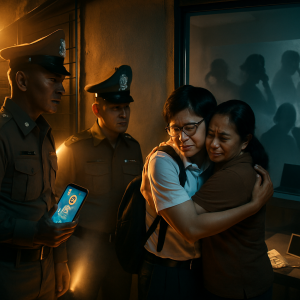As Bangkok awoke on a Monday morning, the infamous haze hung heavy in the air once more—a reminder that air quality in this bustling metropolis can still take a turn for the worse. Snapping a photo from the bustling streets, it’s clear that the capital was blanketed beneath a murky shroud of PM2.5 dust. But it wasn’t just Bangkok; the haze was an unwelcome visitor across 57 of Thailand’s 76 provinces.
Diving into the morning’s report, the Geo-Informatics and Space Technology Development Agency (Gistda) marked the day with concern. By 7 am, hazardous-to-health levels of PM2.5—fine particulate matter no larger than 2.5 micrometers —pervaded the North, Northeast, Central Plain, and East. In stark contrast, the southern region was basking in blissfully safer air.
The question is: just how bad was it? To say it was significant would be an understatement. The government places the “safe” level of PM2.5 at a cautious 37.5 micrograms per cubic meter over 24 hours. By that measure, Bueng Kan was the poster child for poor air quality, topping the charts with a staggering 146.2µg/m³. Trailing not too far behind were Nong Khai with 131.5, followed by Loei (121.3), Nan (118.1), and Phrae (117.6).
Our tour through this atmospheric minefield of provinces continues: we find Mae Hong Son clocking in at 114.1, Lampang 106.4, and Sing Buri peeking just over the century mark at 105.4. In fact, a total of 16 provinces surpassed that triple-digit mark, leaving a smoky trail from Uttaradit at 104.2 to the closer-to-home stats of Bangkok, at a less alarming but still concerning 99.7.
The list doesn’t end there—42 other provinces met the scarlet standard, veering into dangerous territory between 75.4 to 99.4 micrograms per cubic meter. Cities such as Ayutthaya, the mountainous charms of Chiang Mai and Chiang Rai, and the sprawling stretches of Nakhon Ratchasima all took part in this less-than-healthy air affair. However, to end on a slightly more optimistic note, a quintet of provinces like Amnat Charoen and Prachuap Khiri Khan experienced an orange-level alert, affecting health with readings tapering from 60.6 to 73.1µg/m³.
Spared from the oppressive grey, Krabi stood out with a moderate air quality rating, displaying a sunny disposition even through the yellow haze of 28.5µg/m³. Perhaps most enviable were the 13 southern provinces—those fortunate ones cloaked in the green of good air quality. From the coastal calm of Phuket and Phangnga to the vibrant serenades of Songkhla and Yala, their air quality ranged comfortably between 15.4 to 23.9µg/m³, leaving the rest of the nation longing for clear skies ahead.
For now, the haze lingers, and the dance of a bustling city continues beneath its veiled canopy. But with each gray morning comes the hope of a clearer tomorrow—and perhaps, a breath of fresh air.


















This air quality issue is getting serious in Thailand. When will the government take real action on this?
They’ve talked about it for years but nothing concrete happens. We need stricter emissions laws and better enforcement.
But don’t stricter emissions laws also hurt the economy? It’s a difficult balance.
True, but isn’t public health more important than immediate economic benefits? We need sustainable solutions.
I was planning a trip to Bangkok, and now I’m worried about health hazards. Is it really that bad?
I’ve been here for a week. It fluctuates, but if you have respiratory issues, best to be cautious.
Thanks for the advice. Maybe I’ll stick to the southern areas for now.
Can you imagine how bad it is for children breathing this every day?
It’s terrible. Long-term exposure can lead to serious health issues. Awareness is crucial.
I wish schools would do more air quality education. Kids need to know this too.
I don’t think the air quality is as bad as people say. The media always blows things out of proportion.
Tell that to people living in heavily polluted areas. Science doesn’t lie.
I just think we need more local and reliable data before panicking.
At least Bangkok still has things like public transportation to navigate through the smog.
True, but it also contributes to the pollution problem! More electric buses could help.
Absolutely! Hopefully, we’ll see more sustainable options soon.
The southern provinces sound like paradise in comparison. Maybe we all need to move south!
The beaches are great, but we need to protect them too. Pollution isn’t just about air.
That’s true. Environmental protection needs to be holistic.
Can’t believe some provinces have readings over 140! How are schools handling this?
Many schools are keeping kids indoors and increasing the use of air purifiers.
Good to hear. I hope more schools can afford those measures.
Does anyone know why the south has better air quality than the rest of the country?
Primarily due to wind patterns and the lack of industrial activity compared to the north and central regions.
Makes sense. Do you think these patterns will continue?
Living in Nong Khai and the air is suffocating. Government data doesn’t capture the full reality.
Feel that. It’s like we’re living under a dome of smog. We need voices from the ground.
Always worth carrying N95 masks if you’re visiting northern Thailand during these tough times.
Yes, masks can be a life saver in more than one way! I always pack a few.
Wish locals would plant more trees to help combat the haze.
Meditation can’t disperse smog, but it helps me cope with the anxiety of living in this environment.
Maybe it’s time to invest in air purifiers for our homes?
Is anyone organizing a protest for more government action? Time to voice our concerns!
Would be interesting to see how indoor air quality compares. Has anyone measured it?
It’s often darkest before dawn. I believe we’ll find solutions soon.